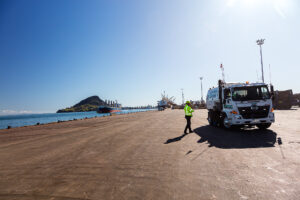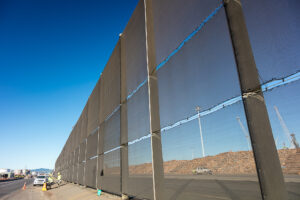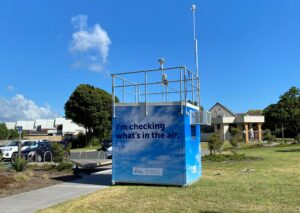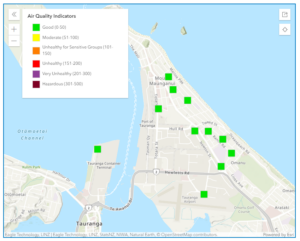Pollution monitors on the Port of Tauranga boundary show a dramatic improvement in air quality since 2019.
The improvements include reductions in sulphur dioxide and dust. Port of Tauranga has undertaken a range of initiatives to reduce airborne dust. Vacuum sweeper trucks collect dust and debris from the wharves, and concrete barriers have been installed to keep traffic and heavy equipment on more frequently swept roadways.
Collected dust and debris is recycled, with bark shed by export logs composted into garden products.
Close to two kilometres of wind fences encourage any airborne dust to settle on the ground, where it can be swept up. The Port also enforces wind limits on handling potentially dusty cargoes.
A recent report for the Toi Te Ora Public Health unit identified air quality improvements since 2019, just before the Mount Maunganui industrial zone was designated a “polluted airshed.” The study showed a reduction in fine dust (called PM10), with maximum daily PM10 concentrations on a port boundary reducing by 28% in 2022 compared with 2019.
In addition, the introduction of mandatory low sulphur shipping fuels in early 2020 has had a major impact on improving air quality by reducing sulphur dioxide.
Port of Tauranga has recently agreed to help fund some of the air quality monitoring in the industrial area to enable Bay of Plenty Regional Council to introduce supplementary air sensors and a higher grade air quality monitor into nearby residential areas. The council is posting real-time air quality indicators from the sensors on its website. The 12 new sensors, while not as accurate as the monitors in the industrial area, are designed to detect particulate matter – including salt-laden air, as well as NO2 (nitrogen dioxide), which can be generated from ships’ engines, petrol and diesel vehicles.
Dust apportionment study
Despite the improvements in air quality in recent years, we know that some Mount Maunganui residents are still concerned about dust. To help inform action plans for industry, Port of Tauranga is installing additional dust monitors close to residential areas. The first unit is located near Zespri International’s head office on Maunganui Road.
These monitors will collect dust samples that can be analysed. Although the monitors will not be able to identify all sources of dust, they will be able to give us a better picture of some general dust sources, this includes sea spray, petrol and diesel exhaust pollution, ship exhaust emissions, and other potential dust sources.



